A Fuzzy Logic Approach for the Reduction of Mesh-Induced Error in CFD Analysis: A Case Study of an Impinging Jet
Abstract
1. Introduction
2. Materials and Methods
2.1. The Research Object
2.2. Computational Domain Discretization
- Si: the distance from the node on the impinged wall to node i,
- R: the ratio limited by 0.25 < R < 4.0, and
- N: the total number of nodes resulting from the average axial spacing (D/320).
- u: the friction velocity at the nearest wall,
- y: the distance to the nearest wall, and
- ν: the local kinematic viscosity of a given fluid.
2.3. Mesh Parameters: Grid Convergence Index Approach
- ΔAi: the area of the ith cell, and
- N: the total number of cells in the computational domain.
2.4. Mesh Parameters: Fuzzy Logic Approach
- Lf: output variable,
- D: nozzle diameter, and
- S1: first layer thickness.
2.5. The Computational Model
- x: axial coordinate,
- r: radial coordinate,
- vx: axial velocity, and
- vr: radial velocity.
- ,
- Μ: molecular viscosity, and
- vz: swirl velocity.
2.6. The Experimental Research
3. Results and Discussion
- Vr: radial component of the velocity (m/s), and
- Vinlet: average jet velocity at the inlet (m/s).
4. Conclusions
Author Contributions
Funding
Conflicts of Interest
References
- Chirade, S.; Ingole, S.; Sundaram, K. Review of Correlations on Jet Impingement Cooling. Int. J. Sci. Res. 2015, 4, 3107–3111. [Google Scholar]
- Simionescu, S.M.; Tanase, N.O.; Broboana, D.; Balan, C. Impinging Air Jets on Flat Surfaces at Low Reynolds Numbers. Energy Proced. 2017, 112, 194–203. [Google Scholar] [CrossRef]
- Zhang, W.; Chai, Z.; Shi, B.; Guo, Z. Lattice Boltzmann study of flow and mixing characteristics of two-dimensional confined impinging streams with uniform and non-uniform inlet jets. Comput. Math. Appl. 2013, 65, 638–647. [Google Scholar] [CrossRef]
- Xu, Z.; Hangan, H. Scale, boundary and inlet condition effects on impinging jets. J. Wind Eng. Ind. Aerodyn. 2008, 96, 2383–2402. [Google Scholar] [CrossRef]
- Liu, X.; Yue, S.; Lu, L.; Gao, W.; Li, J. Experimental and numerical studies on flow and turbulence characteristics of impinging stream reactors with dynamic inlet velocity variation. Energies 2018, 11, 1717. [Google Scholar] [CrossRef]
- Gnatowska, R. A Study of Downwash Effects on Flow and Dispersion Processes around Buildings in Tandem Arrangement. Pol. J. Environ. Stud. 2015, 24, 1571–1577. [Google Scholar] [CrossRef]
- Kim, J.; Hangan, H. Numerical simulations of impinging jets with application to downbursts. J Wind Eng. Ind. Aerodyn. 2007, 95, 279–298. [Google Scholar] [CrossRef]
- Zuckerman, N.; Lior, N. Jet impingement heat transfer: Physics, correlations, and numerical modeling. Adv. Heat Transf. 2006, 39, 565–631. [Google Scholar]
- Wei, T.-W.; Oprins, H.; Cherman, V.; van der Plas, G.; de Wolf, I.; Beyne, E.; Baelmans, M. Experimental characterization and model validation of liquid jet impingement cooling using a high spatial resolution and programmable thermal test chip. Appl. Therm. Eng. 2019, 152, 308–318. [Google Scholar] [CrossRef]
- Singh, A.; Prasad, B. Influence of novel equilaterally staggered jet impingement over a concave surface at fixed pumping power. Appl. Therm. Eng. 2019, 148, 609–619. [Google Scholar] [CrossRef]
- Yang, X.; Liu, Z.; Zhao, Q.; Liu, Z.; Feng, Z.; Guo, F.; Ding, L.; Simon, T.W. Experimental and numerical investigations of overall cooling effectiveness on a vane endwall with jet impingement and film cooling. Appl. Therm. Eng. 2019, 148, 1148–1163. [Google Scholar] [CrossRef]
- Hosain, M.L. CFD Simulation of jet cooling and implementation of flow solvers in GPU. Master’s Thesis, Royal Institute of Technology, Stockholm, Sweden, 2013. [Google Scholar]
- Penumadu, P.S.; Rao, A.G. Numerical investigations of heat transfer and pressure drop characteristics in multiple jet impingement system. Appl. Therm. Eng. 2017, 110, 1511–1524. [Google Scholar] [CrossRef]
- Hadžiabdić, M.; Hanjalić, K. Vortical structures and heat transfer in a round impinging jet. J. Fluid Mech. 2008, 596, 221–260. [Google Scholar] [CrossRef]
- Gauntner, J.W.; Hrycak, P.; Livingood, J. Survey of Literature on Flow Characteristics of a Single Turbulent Jet Impinging on a Flat Plate; National Aeronautics and Space Administration: Washington, DC, USA, 1970. [Google Scholar]
- Fitzgerald, J.A.; Garimella, S.V. A study of the flow field of a confined and submerged impinging jet. Int. J. Heat Mass Transf. 1998, 41, 1025–1034. [Google Scholar] [CrossRef]
- Tahsini, A.; Mousavi, S.T. Parametric Study of Confined Turbulent Impinging Slot Jets upon a Flat Plate. Int. J. Aerosp. Mech. Eng. 2012, 6, 2794–2798. [Google Scholar]
- Cooper, D.; Jackson, D.; Launder, B.E.; Liao, G. Impinging jet studies for turbulence model assessment—I. Flow-field experiments. Int. J. Heat Mass Transf. 1993, 36, 2675–2684. [Google Scholar] [CrossRef]
- Geers, L.F.G.; Hanjalić, K.; Tummers, M.J. Wall imprint of turbulent structures and heat transfer in multiple impinging jet arrays. J. Fluid Mech. 2006, 546, 255–284. [Google Scholar] [CrossRef]
- Benmouhoub, D.; Mataoui, A. Turbulent heat transfer from a slot jet impinging on a flat plate. J. Heat Transf. 2013, 135, 102201. [Google Scholar] [CrossRef]
- Jaramillo, J.E.; Trias, F.X.; Gorobets, A.; Pérez-Segarra, C.D.; Oliva, A. DNS and RANS modelling of a turbulent plane impinging jet. Int. J. Heat Mass Transf. 2012, 55, 789–801. [Google Scholar] [CrossRef]
- Krishan, G.; Aw, K.C.; Sharma, R.N. Synthetic jet impingement heat transfer enhancement—A review. Appl. Therm. Eng. 2018, 149, 1305–1323. [Google Scholar] [CrossRef]
- Taghinia, J.; Rahman, M.M.; Siikonen, T. CFD study of turbulent jet impingement on curved surface. Chin. J. Chem. Eng. 2016, 24, 588–596. [Google Scholar] [CrossRef]
- Sosnowski, M.; Krzywanski, J.; Gnatowska, R. Polyhedral meshing as an innovative approach to computational domain discretization of a cyclone in a fluidized bed CLC unit. In Proceedings of the E3S Web of Conferences, Cracow, Poland, 21–23 September 2016. [Google Scholar]
- Sosnowski, M.; Krzywanski, J.; Grabowska, K.; Gnatowska, R. Polyhedral meshing in numerical analysis of conjugate heat transfer. In Proceedings of the EPJ Web of Conferences, Mikulov, Czech Republic, 21–24 November 2017; p. 02096. [Google Scholar]
- Sosnowski, M.; Gnatowska, R.; Grabowska, K.; Krzywański, J.; Jamrozik, A. Numerical Analysis of Flow in Building Arrangement: Computational Domain Discretization. Appl. Sci. 2019, 9, 941. [Google Scholar] [CrossRef]
- Sosnowski, M. Computational domain discretization in numerical analysis of flow within granular materials. In Proceedings of the EPJ Web of Conferences, Mikulov, Czech Republic, 21–24 November 2017; Volume 180, p. 02095. [Google Scholar]
- Sosnowski, M.; Gnatowska, R.; Sobczyk, J.; Wodziak, W. Numerical modelling of flow field within a packed bed of granular material. In Proceedings of the Journal of Physics: Conference Series, Zawiercie, Poland, 9–12 September 2018; Volume 1101, p. 012036. [Google Scholar]
- Sosnowski, M. The influence of computational domain discretization on CFD results concerning aerodynamics of a vehicle. J. Appl. Mathem. Comput. Mechan. 2018, 17, 79–88. [Google Scholar] [CrossRef]
- Celik, I.B.; Ghia, U.; Roache, P.J.; Freitas, C.; Coloman, H.; Raad, P. Procedure for estimation and reporting of uncertainty due to discretization in CFD applications. J. Fluids Eng.-Trans. ASME 2008, 130, 078001. [Google Scholar]
- Krzywanski, J.; Wesolowska, M.; Blaszczuk, A.; Majchrzak, A.; Komorowski, M.; Nowak, W. The non-iterative estimation of bed-to-wall heat transfer coefficient in a CFBC by fuzzy logic methods. Proced. Eng. 2016, 157, 66–71. [Google Scholar] [CrossRef]
- Krzywanski, J.; Wesolowska, M.; Blaszczuk, A.; Majchrzak, A.; Komorowski, M.; Nowak, W. Fuzzy logic and bed-to-wall heat transfer in a large-scale CFBC. Int. J. Numer. Methods Heat Fluid Flow 2018, 28, 254–266. [Google Scholar] [CrossRef]
- Blaszczuk, A.; Krzywanski, J. A comparison of fuzzy logic and cluster renewal approaches for heat transfer modeling in a 1296 t/h CFB boiler with low level of flue gas recirculation. Arch. Thermodyn. 2017, 38, 91–122. [Google Scholar] [CrossRef]
- Ross, T.J. Fuzzy Logic with Engineering Applications, 3rd ed.; Wiley: Hoboken, NJ, USA, 2013. [Google Scholar]
- Krzywanski, J.; Nowak, W. Modeling of bed-to-wall heat transfer coefficient in a large-scale CFBC by fuzzy logic approach. Int. J. Heat Mass Transf. 2016, 94, 327–334. [Google Scholar] [CrossRef]
- Takagi, T.; Sugeno, M. Fuzzy identification of systems and its applications to modeling and control. IEEE Trans. Syst. Man Cybern. 1985, SMC-15, 116–132. [Google Scholar] [CrossRef]
- Launder, B.E. Second-moment closure and its use in modelling turbulent industrial flows. Int. J. Numer. Methods Fluids 1989, 9, 963–985. [Google Scholar] [CrossRef]
- López, A.; Nicholls, W.; Stickland, M.T.; Dempster, W.M. CFD study of jet impingement test erosion using Ansys Fluent and OpenFoam. Comput. Phys. Commun. 2015, 197, 88–95. [Google Scholar] [CrossRef]



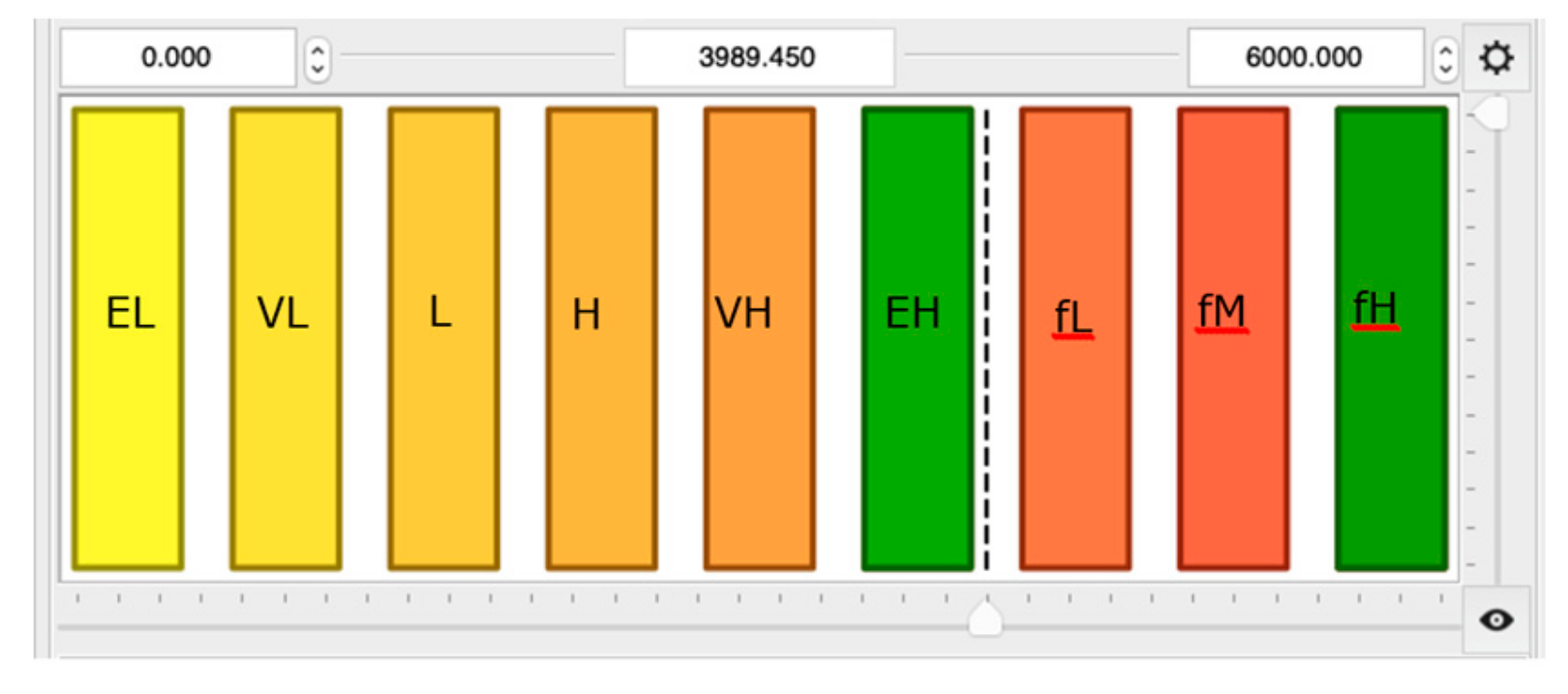

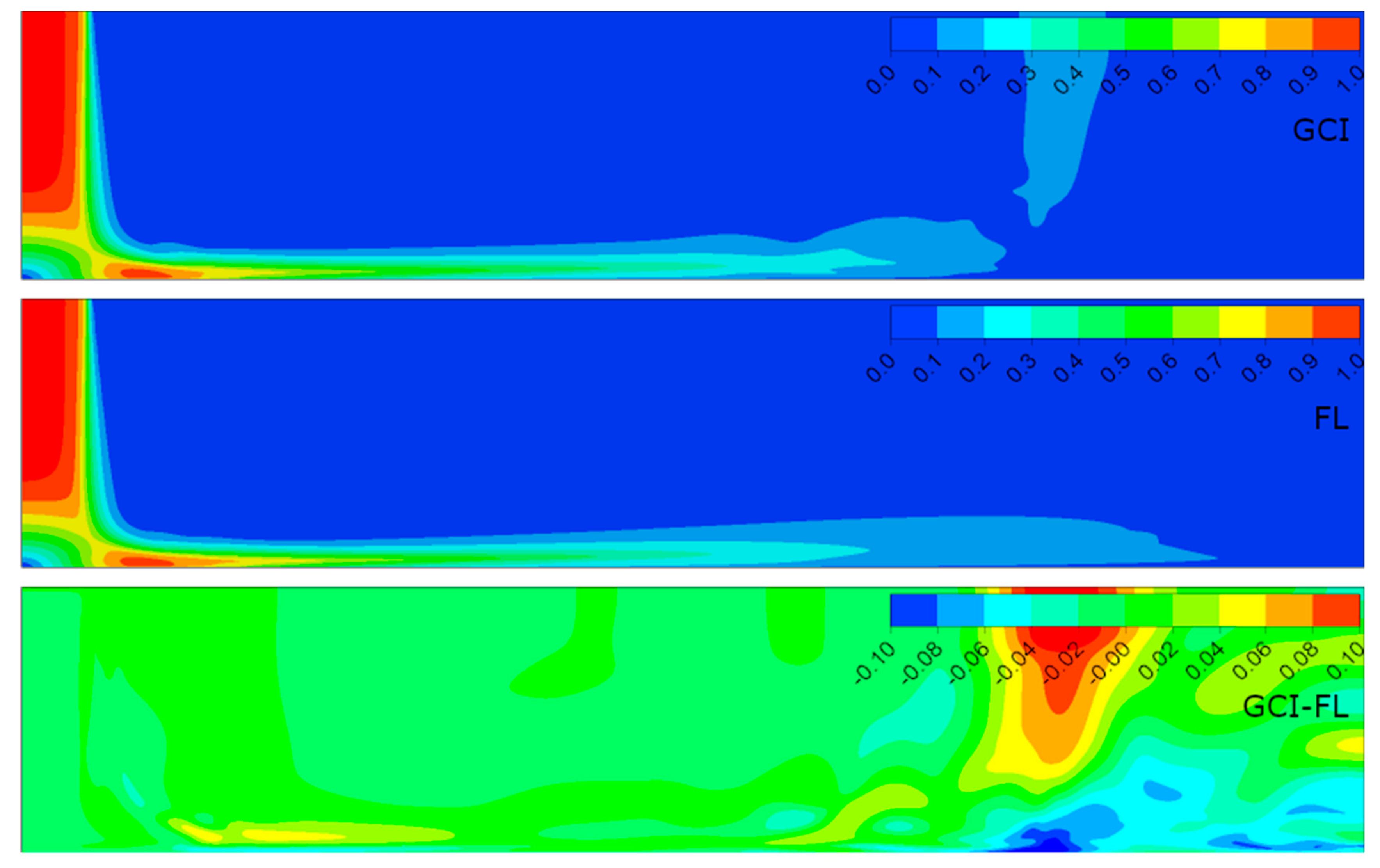
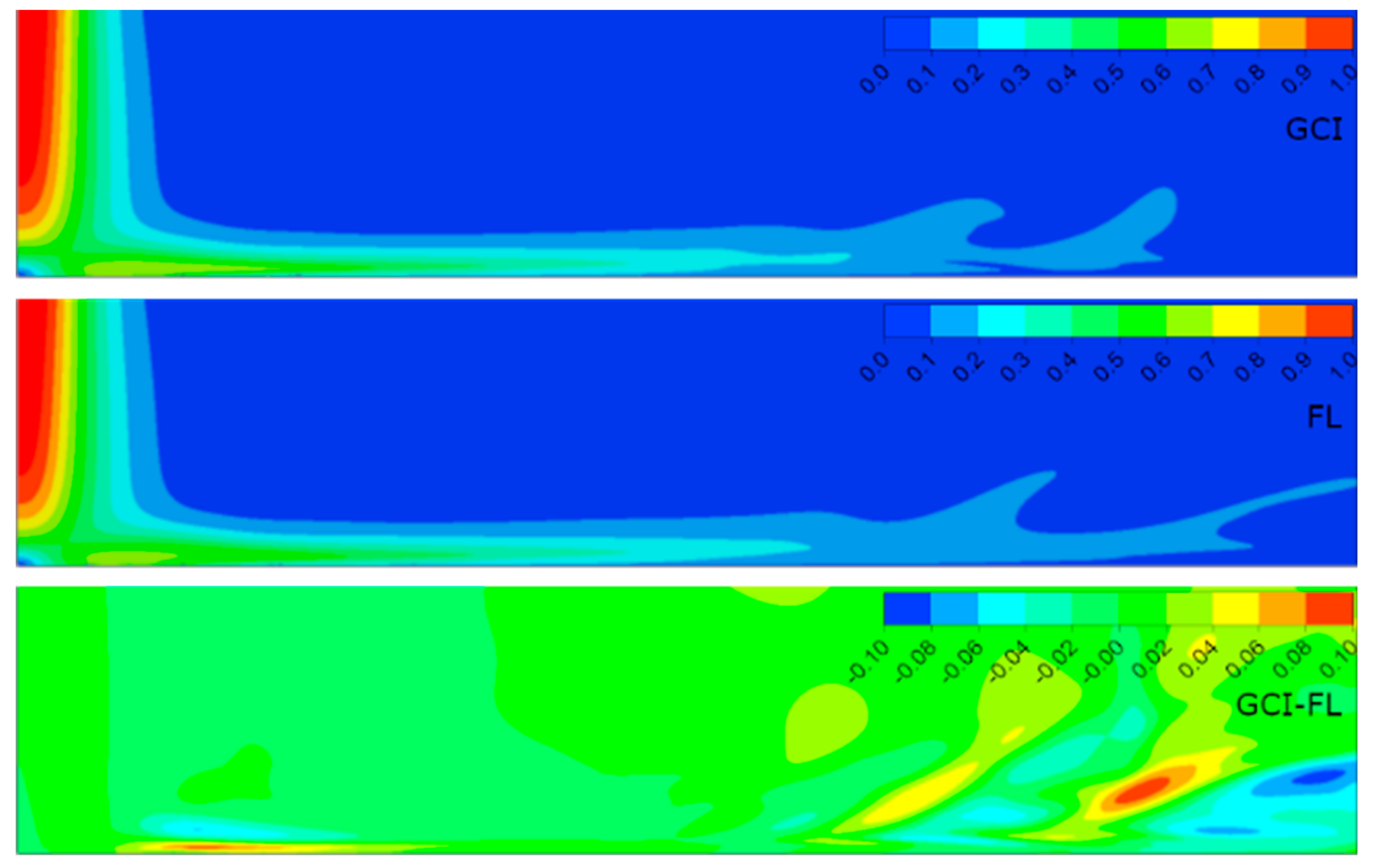
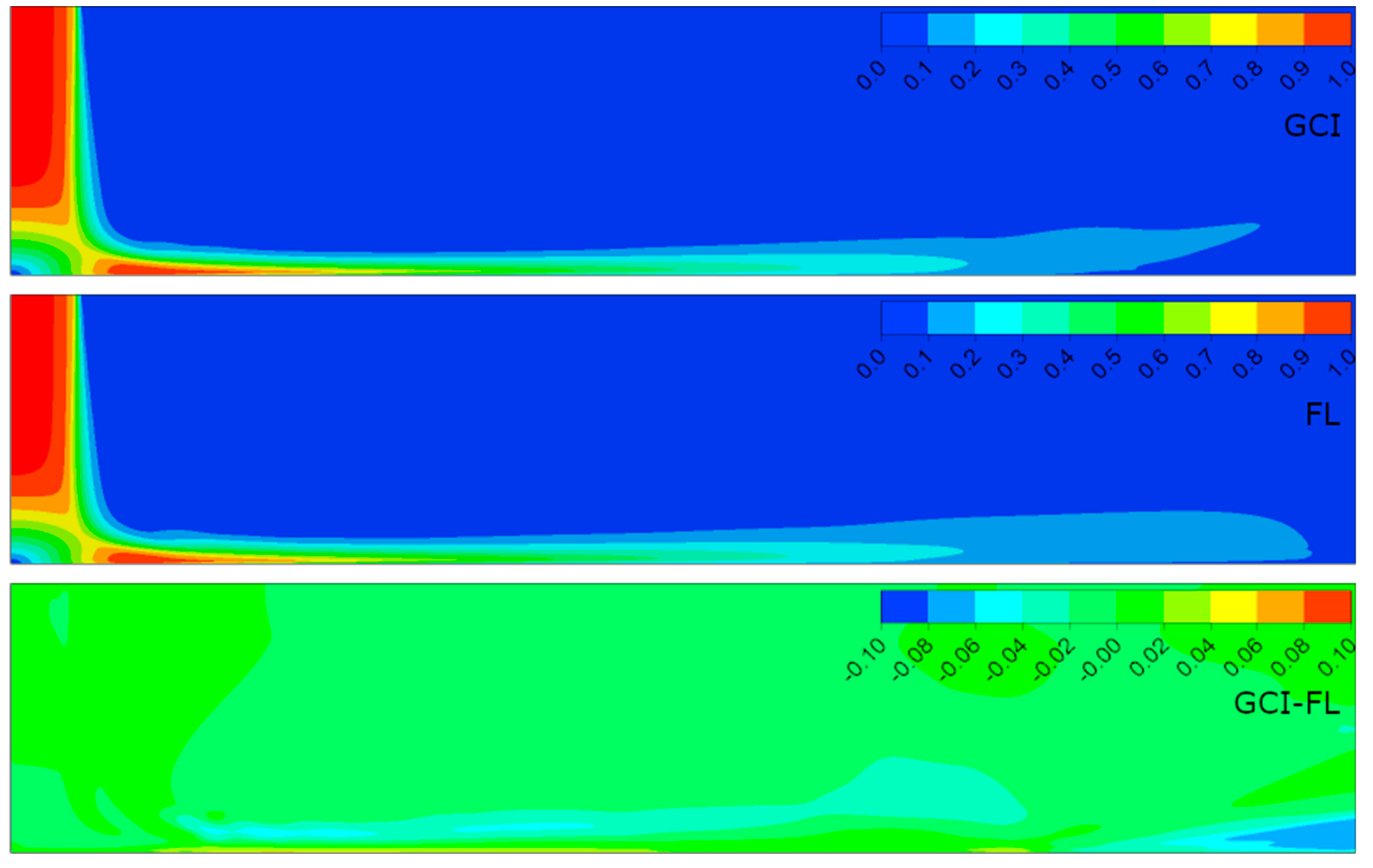
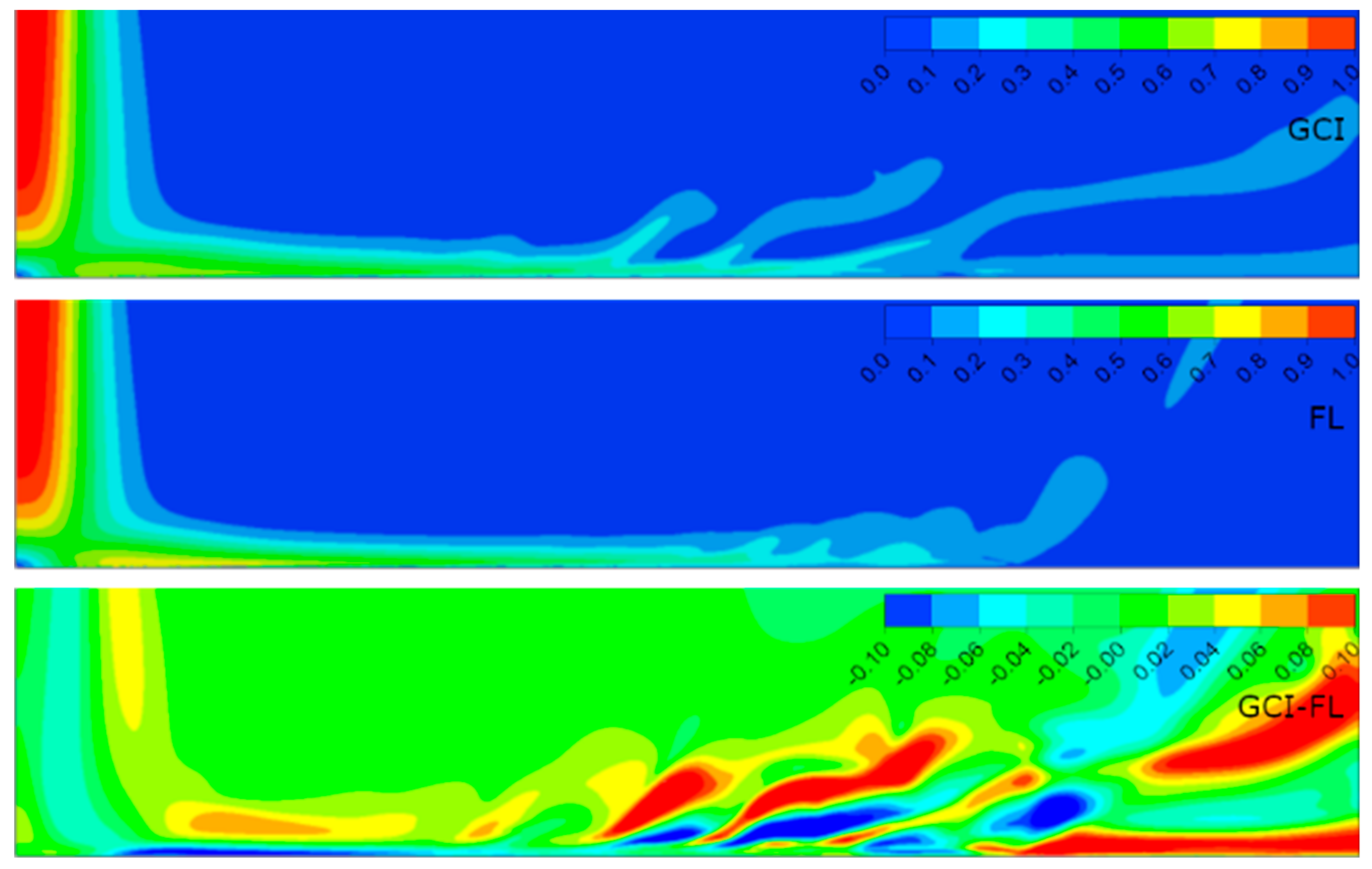
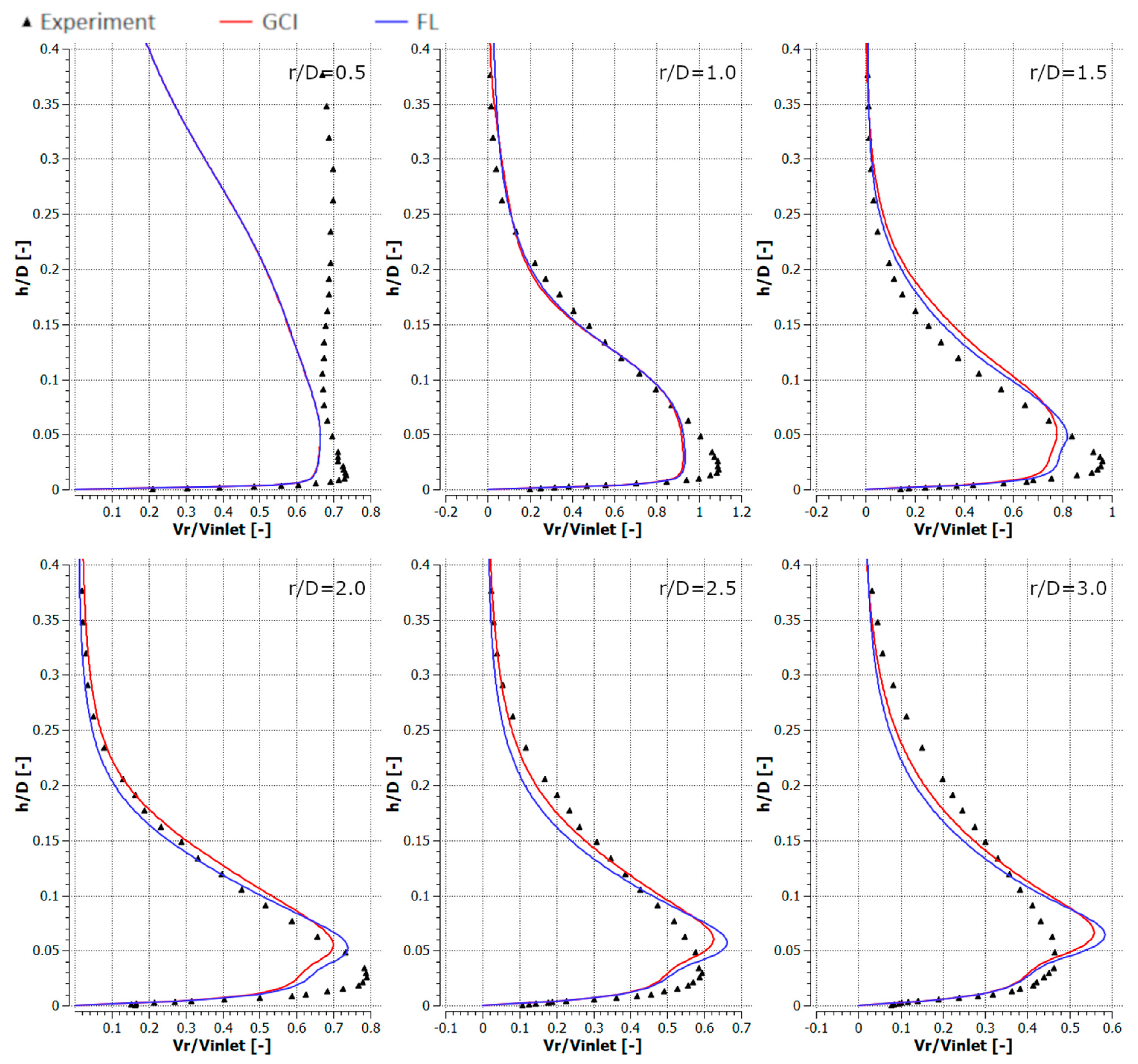
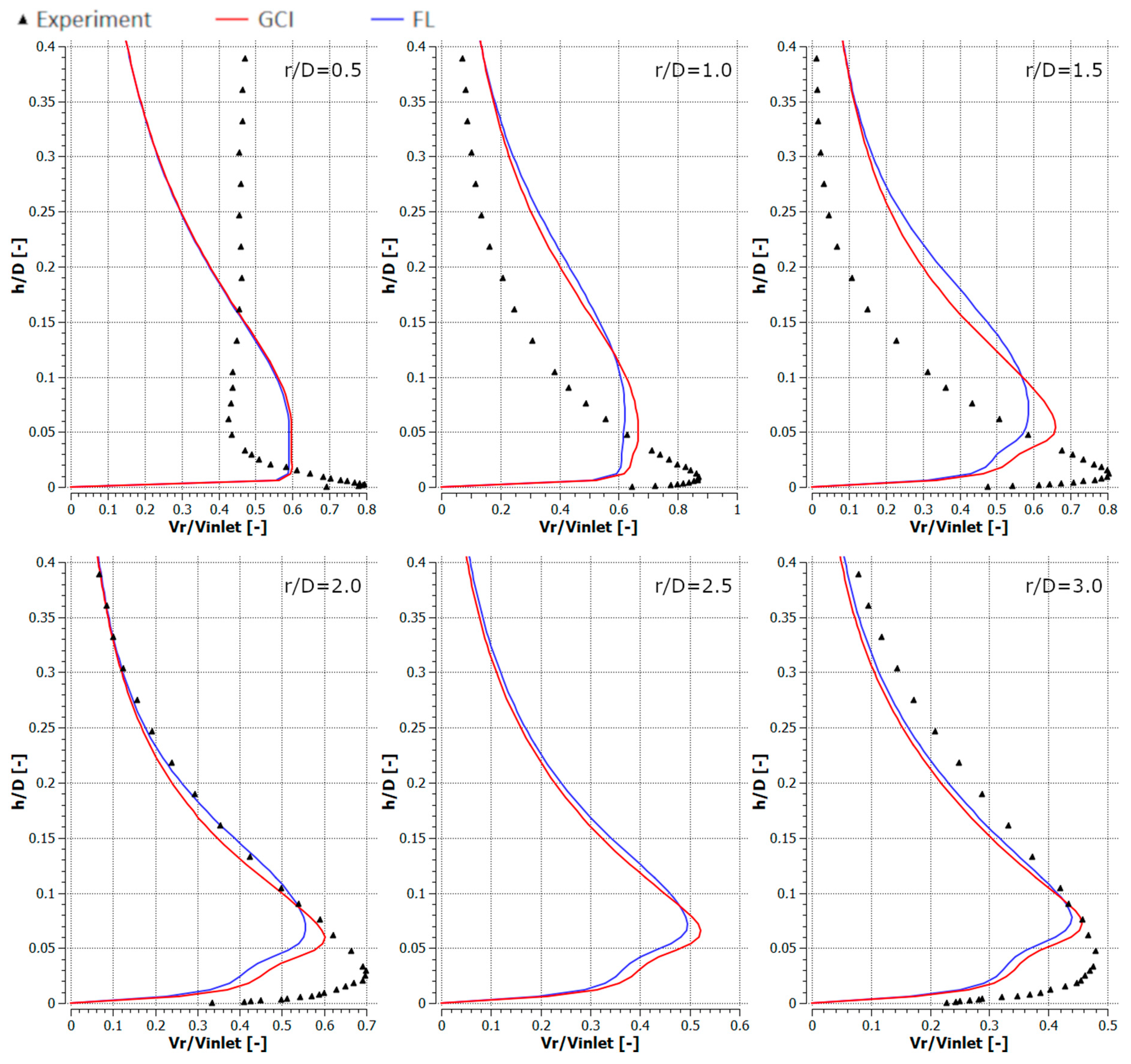
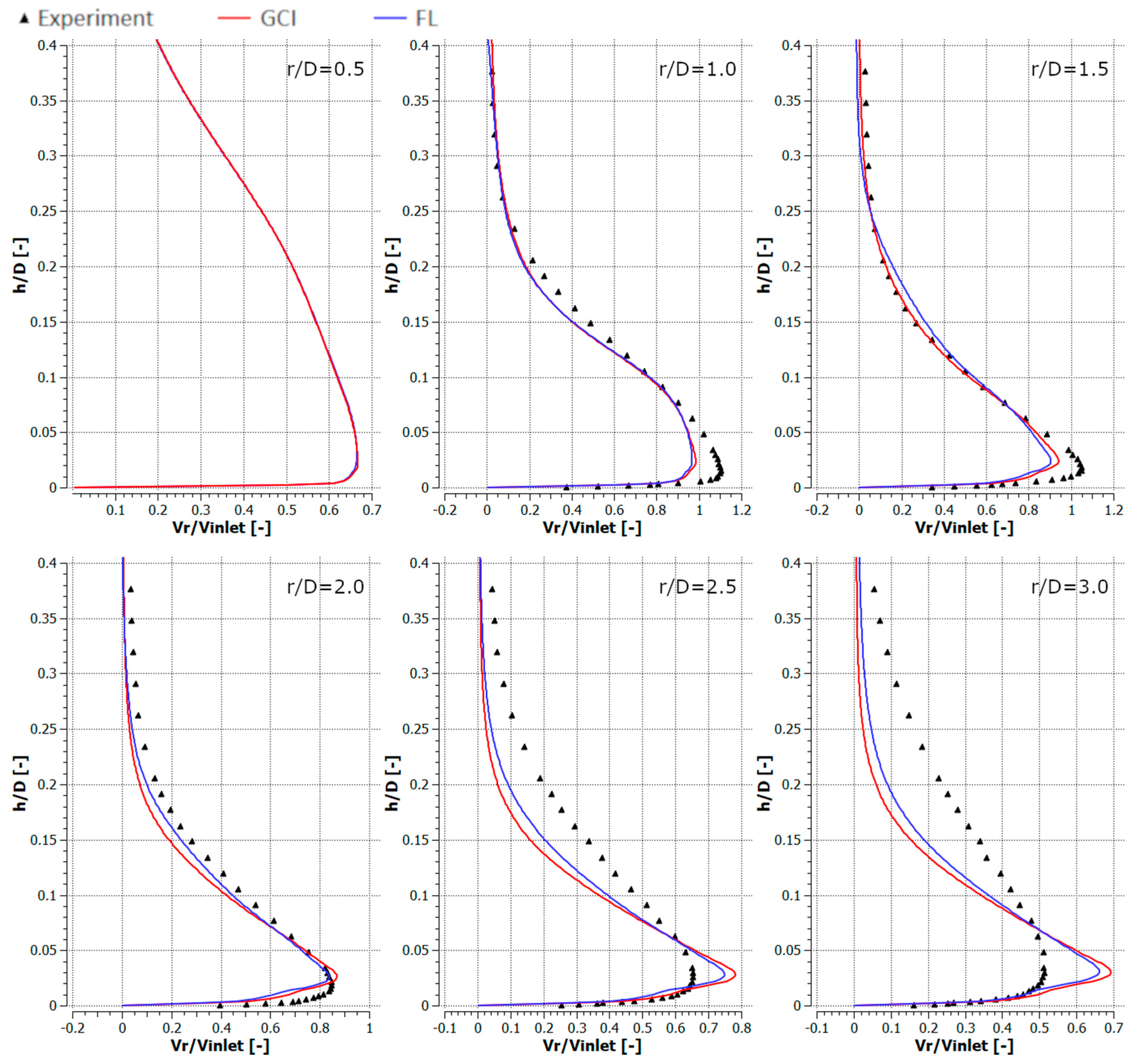
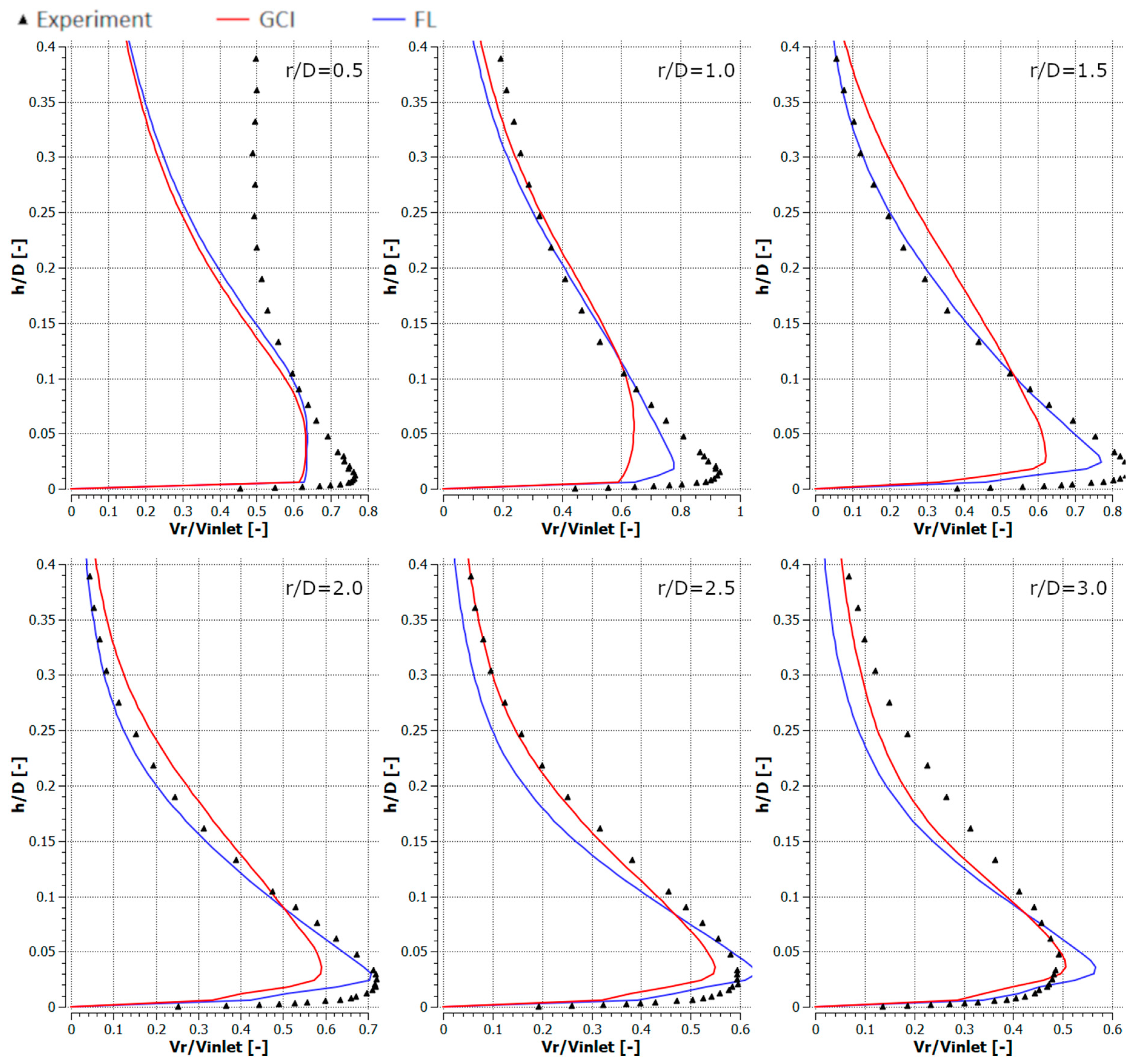
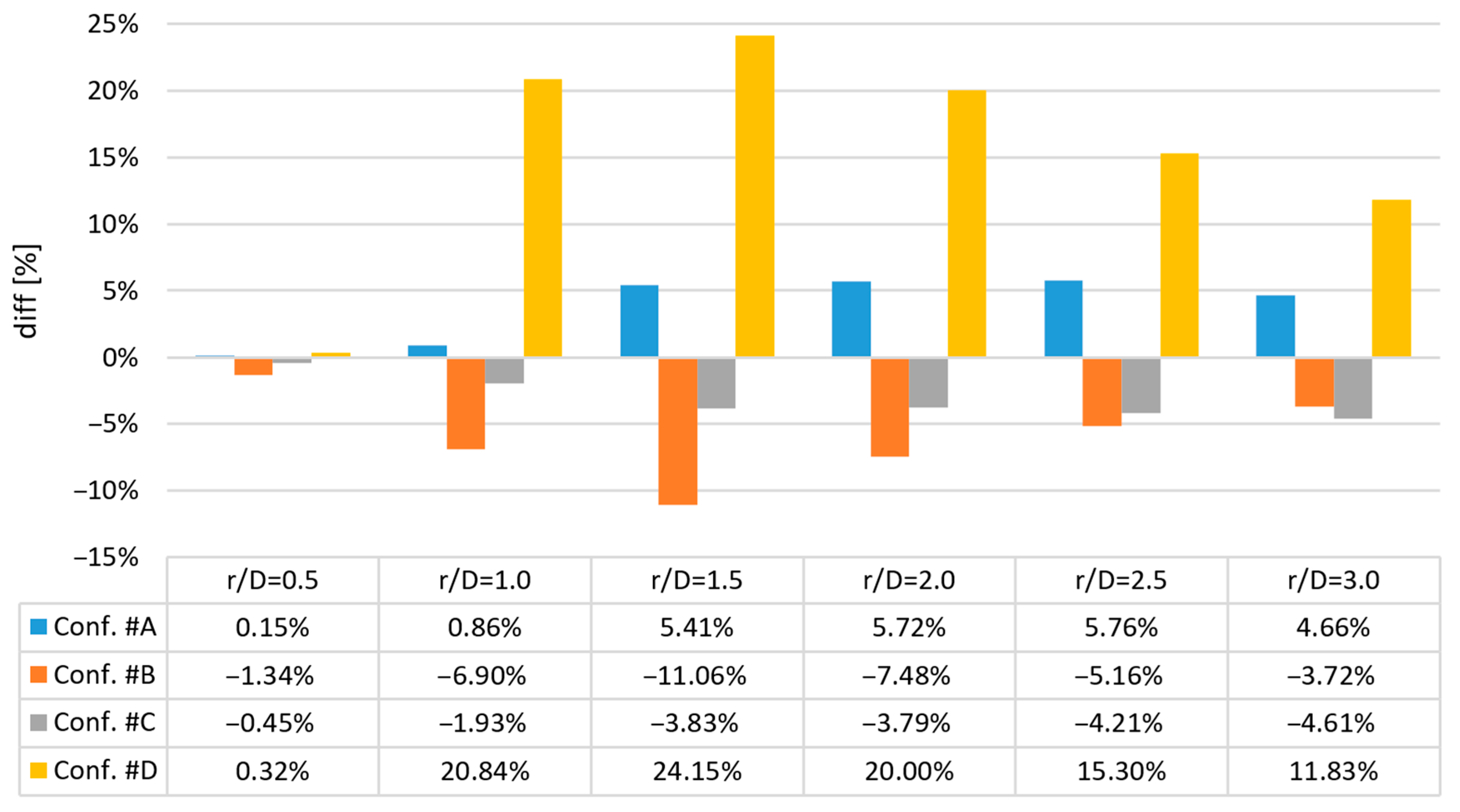
| N (-) | ϕ (-) | h (-) | r (-) | ε (-) | εcoarse/εfine(-) | p (-) | ϕext (-) | ea (%) | eext (%) | GCI (%) |
|---|---|---|---|---|---|---|---|---|---|---|
| 512000 | 0.0425 | 0.0014 | 1.429 | −0.0040 | 0.0228 converged | 10.02 | 0.0426 | 9.29% | 0.27% | 0.34% |
| 250880 | 0.0386 | 0.0020 | 1.400 | −0.0001 | 0.0386 | 0.23% | 0.01% | 0.01% | ||
| 128000 | 0.0385 | 0.0028 | - | - | - | - | - | - |
| Lf | EL | VL | L | H | VH | EH |
|---|---|---|---|---|---|---|
| Re | EL | VL | L | H | VH | EH |
| Lf | fL | fM | fH |
|---|---|---|---|
| H/D | L | M | H |
| Re | H/D | Lf,exp | Lf,calc | Err (%) |
|---|---|---|---|---|
| 23000 | 2 | 1000 | 1015.6 | 1.56 |
| 70000 | 6 | 1000 | 938.6 | 6.14 |
| 23000 | 2 | 3000 | 3619.1 | 20.6 |
| 70000 | 6 | 3000 | 3358.9 | 11.96 |
| Reynolds Number Re (-) | Height to Diameter Ratio H/D (-) | |
|---|---|---|
| Configuration #A | 2.3 × 104 | 2 |
| Configuration #B | 2.3 × 104 | 6 |
| Configuration #C | 7.0 × 104 | 2 |
| Configuration #D | 7.0 × 104 | 6 |
| Minimal Normalized Velocity for GCI-FL (-) | Maximal Normalized Velocity for GCI-FL (-) | |
|---|---|---|
| Configuration #A | −0.131 | 0.121 |
| Configuration #B | −0.087 | 0.095 |
| Configuration #C | −0.077 | 0.065 |
| Configuration #D | −0.187 | 0.182 |
| Configuration | ϕ (-) |
|---|---|
| Configuration #A | 0.04250 |
| Configuration #B | 0.05284 |
| Configuration #C | 0.03323 |
| Configuration #D | 0.04603 |
© 2019 by the authors. Licensee MDPI, Basel, Switzerland. This article is an open access article distributed under the terms and conditions of the Creative Commons Attribution (CC BY) license (http://creativecommons.org/licenses/by/4.0/).
Share and Cite
Sosnowski, M.; Krzywanski, J.; Scurek, R. A Fuzzy Logic Approach for the Reduction of Mesh-Induced Error in CFD Analysis: A Case Study of an Impinging Jet. Entropy 2019, 21, 1047. https://doi.org/10.3390/e21111047
Sosnowski M, Krzywanski J, Scurek R. A Fuzzy Logic Approach for the Reduction of Mesh-Induced Error in CFD Analysis: A Case Study of an Impinging Jet. Entropy. 2019; 21(11):1047. https://doi.org/10.3390/e21111047
Chicago/Turabian StyleSosnowski, Marcin, Jaroslaw Krzywanski, and Radomir Scurek. 2019. "A Fuzzy Logic Approach for the Reduction of Mesh-Induced Error in CFD Analysis: A Case Study of an Impinging Jet" Entropy 21, no. 11: 1047. https://doi.org/10.3390/e21111047
APA StyleSosnowski, M., Krzywanski, J., & Scurek, R. (2019). A Fuzzy Logic Approach for the Reduction of Mesh-Induced Error in CFD Analysis: A Case Study of an Impinging Jet. Entropy, 21(11), 1047. https://doi.org/10.3390/e21111047







